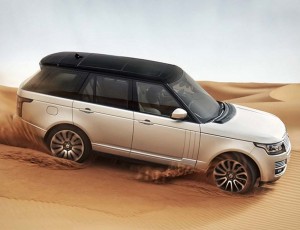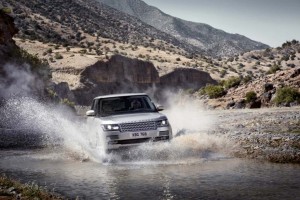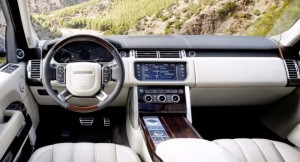Land Rover isn’t dancing around the facts when it describes the new 2013 Range Rover as the most important product it will be bringing out over the next few years. Though sales may be dwarfed by the wildly successful new Evoque, the Range Rover that debuted today at London’s Royal Ballet School is the model that sets the standard for the British marque.
And by radically slashing the weight of the new model, Land Rover shows it can bring the classic SUV into a new era where mass and mileage become increasingly critical.
“The new Range Rover preserves the essential, unique character of the vehicle – that special blend of luxury, performance and unmatched all-terrain capability,” said John Edwards, Land Rover’s Global Brand Director. “However, its clean sheet design and revolutionary lightweight construction have enabled us to transform the experience for luxury vehicle customers, with a step change in comfort, refinement and handling.”
According to Land Rover, the overall weight of the 2013 Range Rover drops by as much as 926 pounds, depending on the model and the market. The aluminum body shell is lighter than the steel body of a Mini Countryman. The American version will maintain its 5.0-liter V-8 and lose 700 pounds, which will mean both better performance and improved mileage.
Actually, the U.S. gets two V-8s, starting with a naturally-aspirated package making 375 hp and 375 lb-ft of torque and launching the big ute to 60 in 6.5 seconds. That will be cut to 5.1 seconds in the supercharged edition making 510 hp and 461 lb-ft.
There will be a diesel for the European market, incidentally, as well as a breakthrough super-high-mileage diesel-hybrid is in the works for Europe, however. Considering the lower weight of the new model, it will yield the sort of fuel economy numbers once considered quite respectable for a midsize sedan — 45 miles per the 5-quart British gallon. (For the math-challenged, that’d be 36 mpg with a 4-qt U.S. gallon.) The system pairs a 3.0-liter V-6 turbodiesel with a single electric motor to make a combined 333 horsepower. The system stores power in a 1.7 kWh lithium-ion battery.
And perhaps the maker will even rethink its diesel options for the U.S. considering the growing sales success of other European makers, such as Mercedes-Benz and BMW.
The basic shape of the iconic ute has received some modern updating. But what buyers may be more interested in is the added 4.7 inches of legroom.
“Designing the next generation Range Rover, following over forty years of success, came with a huge responsibility to protect the DNA of such an icon,” said Gerry McGovern, Land Rover Design Director and Chief Creative Officer. “Our design team worked incredibly hard to capture the elegant proportions and pure surfaces which have been a feature of the best Range Rover designs.”
Among the new technical updates are a new power-operated split liftgate and a new standard audiophile system designed by Britain’s renowned Meridian.
The new Range Rover gets an updated version of Terrain Response, meanwhile, a system that allows a driver to adjust everything from vehicle height to brake and throttle settings, as well as gearing, with the turn of a knob.
Significantly, while many makers are sacrificing off-roadability in the name of weight reduction and fuel economy, Land Rover has actually chosen to accentuate the new Range Rover’s capabilities. It’s water fording maximum depth, for example, has been increased 20%, to 35 inches. Credit a new “labyrinth” engine breathing system tucked under the clamshell hood. Impressively, the diesel-hybrid maintains the same water fording height — and Land Rover says it has mounted the LIon battery in a special boron steel cradle to protect it even from the worst obstacles that might tear at the bottom of the chassis.
Meanwhile, off-road ride height, at its maximum setting, is now 11.9 inches. The maker also says ride comfort and handling will both be enhanced by the 2013 Range Rover’s new aluminum double-wishbone front suspension and multi-link rear, along with the revised air springs.
AMong the many creature comforts are the new semi-analyne leathers used in the cabin, a positively vast Panorama sunroof, a new infotainment system that helped engineers trim by half the number of switches on the center console and instrument cluster, and a 29-speaker, 1,700-watt Meridian sound system.
On the other hand, a switch to tires with hire sidewalls should improve ride comfort — and reduce potential off-road tire damage, LR claims.
India’s Tata Motors plans to invest 2 billion British pounds, or more than $3 billion, on a procession of new products, powertrains and technologies, as well as the plants needed to build them. That includes a significant investment for the aluminum body shop at the Solihull plant producing the new Range Rover.
Significantly, while Jaguar is struggling to reverse years of sales declines, new products like the Evoque have paid off for the Land Rover side and the combined JLR allowed parent Tata Motors achieve an after-tax profit of £1,507m for the 2011/2012 fiscal year.
The new Range Rover will meanwhile make its American debut on September 13.



